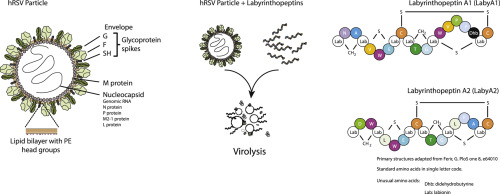当前位置:
X-MOL 学术
›
Antivir. Res.
›
论文详情
Our official English website, www.x-mol.net, welcomes your
feedback! (Note: you will need to create a separate account there.)
Labyrinthopeptins as virolytic inhibitors of respiratory syncytial virus cell entry.
Antiviral Research ( IF 4.5 ) Pub Date : 2020-03-18 , DOI: 10.1016/j.antiviral.2020.104774 Sebastian Blockus 1 , Svenja M Sake 1 , Martin Wetzke 2 , Christina Grethe 1 , Theresa Graalmann 3 , Marina Pils 4 , Ronan Le Goffic 5 , Marie Galloux 5 , Hans Prochnow 6 , Katharina Rox 6 , Stephan Hüttel 7 , Zeljka Rupcic 7 , Bettina Wiegmann 8 , Ronald Dijkman 9 , Marie-Anne Rameix-Welti 10 , Jean-François Eléouët 5 , W Paul Duprex 11 , Volker Thiel 12 , Gesine Hansen 13 , Mark Brönstrup 6 , Sibylle Haid 1 , Thomas Pietschmann 14
Antiviral Research ( IF 4.5 ) Pub Date : 2020-03-18 , DOI: 10.1016/j.antiviral.2020.104774 Sebastian Blockus 1 , Svenja M Sake 1 , Martin Wetzke 2 , Christina Grethe 1 , Theresa Graalmann 3 , Marina Pils 4 , Ronan Le Goffic 5 , Marie Galloux 5 , Hans Prochnow 6 , Katharina Rox 6 , Stephan Hüttel 7 , Zeljka Rupcic 7 , Bettina Wiegmann 8 , Ronald Dijkman 9 , Marie-Anne Rameix-Welti 10 , Jean-François Eléouët 5 , W Paul Duprex 11 , Volker Thiel 12 , Gesine Hansen 13 , Mark Brönstrup 6 , Sibylle Haid 1 , Thomas Pietschmann 14
Affiliation

|
Acute lower respiratory tract infections (ALRI) caused by respiratory syncytial virus (RSV) are associated with a severe disease burden among infants and elderly patients. Treatment options are limited. While numerous drug candidates with different viral targets are under development, the utility of RSV entry inhibitors is challenged by a low resistance barrier and by single mutations causing cross-resistance against a wide spectrum of fusion inhibitor chemotypes. We developed a cell-based screening assay for discovery of compounds inhibiting infection with primary RSV isolates. Using this system, we identified labyrinthopeptin A1 and A2 (Laby A1/A2), lantibiotics isolated from Actinomadura namibiensis, as effective RSV cell entry inhibitors with IC50s of 0.39 μM and 4.97 μM, respectively, and with favourable therapeutic index (>200 and > 20, respectively). Both molecules were active against multiple RSV strains including primary isolates and their antiviral activity against RSV was confirmed in primary human airway cells ex vivo and a murine model in vivo. Laby A1/A2 were antiviral in prophylactic and therapeutic treatment regimens and displayed synergistic activity when applied in combination with each other. Mechanistic studies showed that Laby A1/A2 exert virolytic activity likely by binding to phosphatidylethanolamine moieties within the viral membrane and by disrupting virus particle membrane integrity. Probably due to its specific mode of action, Laby A1/A2 antiviral activity was not affected by common resistance mutations to known RSV entry inhibitors. Taken together, Laby A1/A2 represent promising candidates for development as RSV inhibitors. Moreover, the cell-based screening system with primary RSV isolates described here should be useful to identify further antiviral agents.
中文翻译:

迷宫肽素作为呼吸道合胞病毒细胞进入的解毒抑制剂。
由呼吸道合胞病毒(RSV)引起的急性下呼吸道感染(ALRI)与婴儿和老年患者的严重疾病负担相关。治疗选择有限。虽然正在开发具有不同病毒靶标的众多候选药物,但RSV进入抑制剂的效用受到了低抗性屏障和单个突变的挑战,这些突变导致了针对多种融合抑制剂化学型的交叉耐药。我们开发了一种基于细胞的筛选测定法,用于发现抑制主要RSV分离株感染的化合物。使用该系统,我们确定了迷信素A1和A2(Laby A1 / A2),从纳米猕猴桃分离的羊毛硫抗生素是有效的RSV细胞进入抑制剂,IC50分别为0.39μM和4.97μM,并且具有良好的治疗指数(> 200和> 20 分别)。两种分子均对包括原始分离物在内的多种RSV毒株具有活性,并且在离体原代人气道细胞和体内鼠模型中证实了它们对RSV的抗病毒活性。Laby A1 / A2在预防和治疗方案中具有抗病毒作用,并且在彼此组合使用时表现出协同活性。机理研究表明,Laby A1 / A2可能通过与病毒膜内的磷脂酰乙醇胺部分结合并破坏病毒颗粒膜的完整性而发挥溶酶活性。可能由于其特定的作用方式,Laby A1 / A2抗病毒活性不受已知RSV进入抑制剂常见耐药性突变的影响。两者合计,Laby A1 / A2代表有希望成为RSV抑制剂的发展候选物。此外,
更新日期:2020-03-19
中文翻译:

迷宫肽素作为呼吸道合胞病毒细胞进入的解毒抑制剂。
由呼吸道合胞病毒(RSV)引起的急性下呼吸道感染(ALRI)与婴儿和老年患者的严重疾病负担相关。治疗选择有限。虽然正在开发具有不同病毒靶标的众多候选药物,但RSV进入抑制剂的效用受到了低抗性屏障和单个突变的挑战,这些突变导致了针对多种融合抑制剂化学型的交叉耐药。我们开发了一种基于细胞的筛选测定法,用于发现抑制主要RSV分离株感染的化合物。使用该系统,我们确定了迷信素A1和A2(Laby A1 / A2),从纳米猕猴桃分离的羊毛硫抗生素是有效的RSV细胞进入抑制剂,IC50分别为0.39μM和4.97μM,并且具有良好的治疗指数(> 200和> 20 分别)。两种分子均对包括原始分离物在内的多种RSV毒株具有活性,并且在离体原代人气道细胞和体内鼠模型中证实了它们对RSV的抗病毒活性。Laby A1 / A2在预防和治疗方案中具有抗病毒作用,并且在彼此组合使用时表现出协同活性。机理研究表明,Laby A1 / A2可能通过与病毒膜内的磷脂酰乙醇胺部分结合并破坏病毒颗粒膜的完整性而发挥溶酶活性。可能由于其特定的作用方式,Laby A1 / A2抗病毒活性不受已知RSV进入抑制剂常见耐药性突变的影响。两者合计,Laby A1 / A2代表有希望成为RSV抑制剂的发展候选物。此外,











































 京公网安备 11010802027423号
京公网安备 11010802027423号